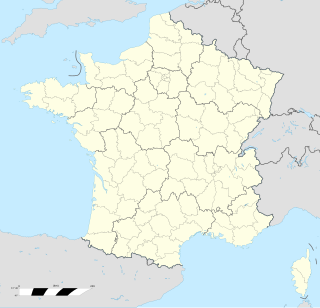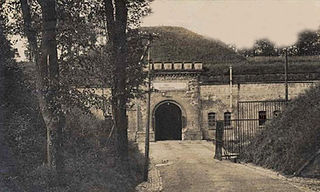 W
WThe fortifications of Metz, a city in northeastern France, are extensive, due to the city's strategic position near the border of France and Germany. After the Franco-Prussian War of 1870, the area was annexed by the newly created German Empire in 1871 by the Treaty of Frankfurt and became a Reichsland. The German Army decided to build a fortress line from Mulhouse to Luxembourg to protect their new territories. The centerpiece of this line was the Moselstellung between Metz and Thionville, in Lorraine.
 W
WThe Feste Wagner, renamed Group Fortifications of Aisne by the French in 1919, is a fort of the second fortified belt of forts from Metz, in Moselle. This group fortification, built in the municipalities of Pournoy-la-Grasse and of Verny, controlled the valley of the Seille. It had its baptism of fire in late 1944, when the Battle of Metz occurred.
 W
WThe Feste von Zastrow, renamed Fort des Bordes by the French in 1919, is a military structure located in the district of Boric in Metz. It is part of the first fortified belt of the forts of Metz. Buried since the construction of the Eastern expressway in 1968, it is covered by a green space, although some remnants of the fort remain visible.
 W
WThe Metz Citadel was a fort built at Metz, northeast France in the second half of the 16th century.
 W
WThe Feste Schwerin, renamed fort Decaen by the French in 1919, is a military installation near Metz. It is part of the first fortified belt of forts of Metz and had its baptism of fire in late 1944, when Battle of Metz occurred.
 W
WThe Feste Kameke, renamed Fort Déroulède by the French in 1919, is a military installation near Metz. It is part of the first fortified belt of forts of Metz and had its baptism of fire in late 1944, in the Battle of Metz.
 W
WThe Feste Leipzig, renamed Group Fortifications Francois-de-Guise after 1919 by the French, is a military structure located in the municipality of Châtel-Saint-Germain, close to Metz. It is part of the second fortified belt of forts of Metz and had its baptism of fire in late 1944, when the Battle of Metz occurred.
 W
WThe Feste Hindersin renamed Gambetta fort by the French in 1919, is a military installation near Metz. It is part of the first fortified belt of forts of Metz and had its baptism of fire in late 1944, when Battle of Metz occurred.
 W
WFort Jeanne d'Arc, also called Fortified Group Jeanne d'Arc, is a fortification located to the west of Metz in the Moselle department of France. It was built by Germany to the west of the town of Rozérieulles in the early 20th century as part of the third and final group of Metz fortifications. The fortification program was started after the German victory of the Franco-Prussian War, which resulted in the annexation of the provinces of Alsace and Lorraine from Germany to France. The Fort Jeanne d'Arc was part of the Moselstellung, a group of eleven fortresses surrounding Thionville and Metz to guard against the possibility of a French attack aimed at regaining Alsace and Lorraine, with construction taking place between 1899 and 1908. The fortification system incorporated new principles of defensive construction to deal with advances in artillery. Later forts, such as Jeanne d'Arc, embodied innovative design concepts such as dispersal and concealment. These later forts were designed to support offensive operations, as an anchor for a pivoting move by German forces into France.
 W
WThe Infanterie-Werk Belle-Croix, renamed Fort Lauvallière after 1919, is a military installation near Metz. It is part of the second fortified belt of forts of Metz.
 W
WThe Feste Lothringen, renamed Group Fortification Lorraine after 1919, is a military installation near Metz. It is part of the second fortified belt of forts of Metz and had its baptism of fire in late 1944, when the Battle of Metz occurred.
 W
WThe Feste Mercy, renamed Feste Freiherr von der Goltz in 1911 and then The Group Fortification Marne in 1919, is a military installation near Metz, in the woods between Jury, Mercy and Ars-Laquenexy. It is part of the second fortified belt of forts of Metz and had its baptism of fire in late 1944, when the Battle of Metz occurred.
 W
WThe Fort de Plappeville, or Feste Alvensleben, is a military fortification located to the northwest of Metz in the commune of Plappeville. As part of the first ring of the fortifications of Metz, it is an early example of a Séré de Rivières system fort. While it did not see action during World War I, it was the scene of heavy fighting between American forces and German defenders at the end of the Battle of Metz, in 1944. After Second World War it became a training center for the French Air Force. Fort 'Alvensleben' has been abandoned since 1995.
 W
WThe Fort de Queuleu is a fortification to the southeast of Metz, near Queuleu, France. Construction began while part of Lorraine was under French rule in 1868. After the interruption of the Franco-Prussian War of 1870-71, the fort was improved between 1872 and 1875 by the German Empire, which had conquered the area in the war. Renamed Fort Goeben, it formed part of the first ring of the fortifications of Metz. Functionally obsolete by the First World War, it saw no military action, but was used by the Germans as a detention center for members of the French Resistance during World War II.
 W
WThe Fort de Saint-Julien, renamed Feste Manteuffel in German, is a military installation near Metz. It is part of the first fortified belt forts of Metz and had its baptism of fire in late 1944 in the Battle of Metz.
 W
WFort Saint-Privat is a fortification near Metz. Part of the forts of Metz, it had its baptism of fire in late 1944 during the Battle of Metz.
 W
WThe Fortifications of Saint-Quentin, or Feste Prinz Friedrich Karl form a fortification group in the Scy-Chazelles municipality located northwest of Metz on the Mont Saint-Quentin. Constituted by forts Diou and Girardin, the group is part of the first fortified belt of forts around Metz and had its baptism of fire in late 1944, when the Battle of Metz occurred.
 W
WThe Feste Haeseler, renamed Group Fortification Verdun after 1919, is a military installation near Metz. Constituted as forts Sommy and Saint-Blaise, the fortified group is part of the second fortified belt of forts of Metz. It had its baptism of fire in late 1944, when the Battle of Metz occurred.
 W
WThe Feste Prinz Regent Luitpold, renamed Group Fortification Yser after 1919, is a military installation near Metz. It is part of the second fortified belt of forts of Metz and had its baptism of fire in late 1944, when the Battle of Metz occurred.